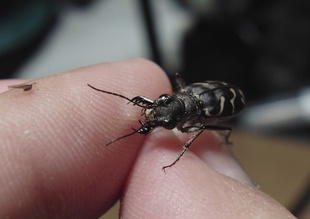
In dynamic locomotory contexts, visual cues often trigger adaptive behaviour by the viewer, yet studies investigating how animals determine impending collisions typically employ either stationary viewers or objects. We described a dynamic situation of visually guided prey pursuit in which both impending prey contact and escape elicit observable adaptive behaviours in the pursuing tiger beetle. We investigated which visual cues may independently control opening and closing of the beetle's jaws during chases of prey dummies. Jaw opening and closing typically occur when prey is within the 60° binocular field, but not at specific distances, angular sizes or time-to-collision. We show that a sign change in the expansion rate of the target image precedes jaw opening (16 ms) and closing (35 ms), signalling to the beetle that it is gaining on the target or that the target is getting away. We discuss the ‘sloppiness' of such variation in the lag of the behavioural response, especially jaw closing, as an adaptation to uncertainty about target position due to degradation of the target image by motion blur from the fast-running beetle.
Cornell Chronicle has a good summary of the paper, with an interview with Cole Gilbert.
DB Zurek, MQ Perkins, and C Gilbert (2014). Dynamic visual cues induce jaw opening and closing by tiger beetles during pursuit of prey. Biology Letters, 20140760
Cornell Chronicle has a good summary of the paper, with an interview with Cole Gilbert.
DB Zurek, MQ Perkins, and C Gilbert (2014). Dynamic visual cues induce jaw opening and closing by tiger beetles during pursuit of prey. Biology Letters, 20140760
 RSS Feed
RSS Feed
